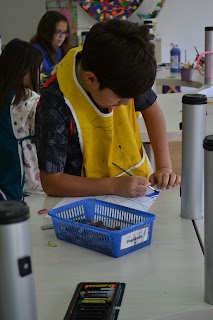Today with students from Level 11 we attended a mosaic workshop organized by the Macedonian Welcome Center in Sulij An in the Old Bazaar. It was a fun experience for the students, an interesting way to learn more about this ancient technique. The method by which mosaics are made hasn't changed much since ancient times. Advancements in tools and materials have made the process easier, quicker, and the results more varied and visually appealing, but over all the process is the same. The most exciting part for the students was breaking the tiles and assembling them in a piece of art or an image of their choice.
For students that are intersted in deepening their knowladge in mosaic techniques, the mmosaic instructur Jasmina is offering mosaic classes;
Ceramic
mosaics workshop for kids (from 10/
above) with Jasmina
Boshevska.
When: 8
October
15 October
22 October
29 October
from
10.00 a.m. - 12.00
Where:
Добредојде Welcome Macedonia
Center
Price:
700 den. per 120 min. Basic
work material included.
Fb – Stone Story design

Short History of Mosaics
Flooring set with small pebbles was used in the Bronze Age in both the Minoan civilization based on Crete and the Mycenaean civilization on mainland Greece. The same idea but reproducing patterns was used in the Near East in the 8th century BCE. In Greece the first pebble flooring which attempted designs dates to the 5th century BCE with examples at Corinth and Olynthus. These were usually in two shades with light geometric designs and simple figures on a dark background. By the end of the 4th century BCE colours were being used and many fine examples have been found at Pella in Macedonia. These mosaics were often reinforced by inlaying strips of terracotta or lead, often used to mark outlines. Indeed, it was not until Hellenistic times in the 3rd century BCE that mosaics really took off as an art form and detailed panels using tesserae rather than pebbles began to be incorporated into patterned floors. Many of these mosaics attempted to copy contemporary wall paintings.Typically Roman subjects were scenes celebrating their gods, domestic themes and geometric designs. The inter-twined rope border effect here is called "guilloche". With the rise of the Byzantine Empire from the 5th century onwards, centred on Byzantium (now Istanbul, Turkey), the art form took on new characteristics. Roman images were absorbed into the typical Christian themes of the Byzantine mosaics, although some work is decorative and some incorporates portraits of Emperors and Empresses.


















































